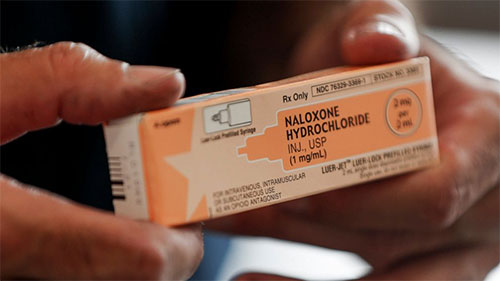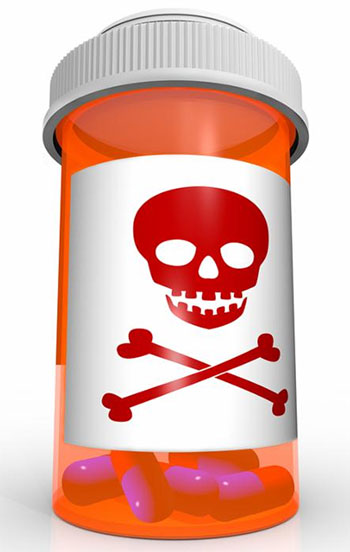Project Tango: Big Pharma Makes the Poison and the Cure
Project Tango was the name given to Purdue Pharma’s business proposition to distribute addictive drugs and then swoop in with the treatment; a Massachusetts lawsuit alleges the Sackler family, who still own controlling interest in the company, developed the idea to drive profits.

The lawsuit alleges that in 2017, Purdue management was concerned the Centers for Disease Control and Prevention’s effort to save lives by reducing opioid doses would force the company “to adjust down our revenue expectations”.
Ignoring warnings by their sales reps, Purdue and the Sacklers continued to push sales of opioid drugs until a mounting number of lawsuits threatened their way of life; a lawsuit by New York City alleges the family then began illegally moving financial assets to protect their millions.
Opioids are not proven effective for long-term pain management. If you suffer from chronic pain there are other nonaddictive options; if you have been on an opioid for several months, it is crucial to get help detoxing and finding another method of pain management.
According to the National Institute on Drug Abuse, every day more than 130 people in the United States die after overdosing on opioids. In October 2017, the Manchester, New Hampshire, Fire Department reported it responds to more calls for drug overdoses than fires, and as of June 2017, opioids had become the leading cause of death among Americans under the age of 50.
Despite a number of public warnings, and a national effort to reduce this lethal trend, overdoses admitted into emergency rooms increased 30% between July 2016 and September 2017 in 45 states.
Provisional data from the U.S. Centers for Disease Control and Prevention (CDC) show the reported number of deaths in the 12-month period ending August 2018 was 67,360. The CDC had predicted 70,424 and believes the number was underreported due to incomplete data.
Despite these facts, there is no evidence of reversal of this growing epidemic, and in October 2018 an advisory committee to the U.S. Food and Drug Administration (FDA) sanctioned the most powerful synthetic opioid painkiller to date – Dsuvia (sufentanil) – 1,000 times stronger than morphine, 50 times more potent than heroin and 10 times stronger than the synthetic opioid fentanyl.
The final approval of the drug was announced November 2, 2018, by FDA Commissioner Scott Gottlieb, who said the drug would not be dispensed for “home use,” and that it will carry a boxed warning about its risks, including death.
The Sackler family, owners of Purdue Pharma, have a combined fortune estimated at $14 billion. The family received nearly $4 billion in profits over the past decade from Purdue, in large part due to sales of OxyContin, an opioid developed in the early 1990s. In an effort to reap greater financial rewards from a growing epidemic killing tens of thousands, Kathe Sackler devised Project Tango.
Sackler Family Propose Project Tango to Increase Profits
Once the family had firmly established themselves in the sales of Oxycontin, they moved on to a new venture: addiction treatment. In early January 2019, a Massachusetts judge ruled to issue an unredacted account of a complaint filed with the state’s attorney general’s office naming Purdue and eight of the Sackler family members as defendants.
According to documents, in September 2014 Kathe Sackler developed a confidential project called Project Tango. This was a secret plan for Purdue Pharmaceuticals to expand their business into the treatment of opioid addiction.
After publicly denying opioids were addictive for decades, she and her staff developed a program on the premise of believing “addictive opioids and opioid addiction” are “naturally linked,” and determined Purdue should span “the pain and addiction spectrum” to become “an end-to-end pain provider.”
According to the court documents, the team reviewed findings and found profits had doubled between 2009 and 2014. This led Kathe Sackler and her staff to conclude the next business opportunity was opioid addiction treatment. They wrote:
“It is an attractive market. Large unmet need for vulnerable, underserved and stigmatized patient population suffering from substance abuse, dependence and addiction.ˮ
Company Documents Allegedly Acknowledge Opioids Are Addictive
The Massachusetts lawsuit reads like a corporate crime drama. It goes on to allege that in February 2015, Project Tango was presented to the board of Purdue Pharmaceuticals as a plan for a joint venture controlled by the Sacklers to sell the addiction medication suboxone (Naloxone).

The team mapped out how patients could first get addicted to opioids through prescription drugs or heroin, and then become consumers of the company’s new drug. They noted even after patients were finished with a first round of suboxone, up to 60% would relapse and need it again. The following month the board shelved Project Tango.
In December 2016, several in the Sackler family had a meeting with staff about a revised version of Project Tango, with the idea of purchasing a company treating opioid addiction with implantable drug pumps. They believed this would be a “strategic fit” since the business treated the “strategically adjacent indication of opioid dependence.”
In January 2018, Richard Sackler received his own patent for a drug to treat addiction. The patent was assigned to another arm of the Sackler pharmaceutical empire, Rhodes Pharmaceuticals. The application stated that opioids are addictive, and called people who became addicted “junkies.”
Today, Rhodes offers the addiction medication Buprenorphine as transdermal patches and sublingual pills, along with a variety of opioid drugs, including hydromorphone (Dilaudid), hydrocodone and morphine.
Meet the Sackler Family – Proud Pushers of the Opioid Epidemic
In 2007, Purdue Pharma paid $634.5 million in fines for fraudulently misbranding Oxycontin and suggesting it was less addictive and less abused than other painkillers. The company was charged with using misleading sales tactics, minimizing risks and promoting it for uses for which it was not appropriately studied.
Today hundreds of lawsuits have been filed in an effort to attach the Sacklers’ personal fortunes and expose their intimate knowledge and participation in the opioid epidemic.
Representatives of eight Sackler family members named as defendants in both the New York and Massachusetts lawsuits made a joint statement to The New York Times in which they said the suits “ignore the fact that the Sackler family has long been committed to initiatives that prevent abuse and addiction,” citing donations to an addiction research and treatment center in Oklahoma.
However, their contribution was in fact a condition of a court-approved settlement in an opioid lawsuit brought by the Oklahoma attorney general. In 2011, the family increased pressure to raise sales numbers, yet in a statement they said they were acting responsibly about “business issues that were highly relevant to doctors and patients.”
According to the lawsuit in Massachusetts, Richard Sackler met with sales reps for several days in January 2011 to discuss how they would promote their newest opioid drug. He demanded to speak to the sales VP to discuss how sales reps could overcome physician resistance and continued to push for increased sales.
By February, the staff had given the family a map showing dangerous prescribers in Massachusetts corresponding with reports of poisonings, burglaries and robberies. These prescribers were code named Region Zero. In March, staff told the Sacklers, Region Zero prescriptions accounted for 10% of their sales.
Purdue Pharma Ignored the Warning Signs
The staff sent the family a report of tactics being used, focusing on this select core physician group, which the company calculated would be most susceptible to lobbying and persuasion. However, the sales reps repeatedly reported concerns that these physicians were writing inappropriate prescriptions.
According to the Massachusetts lawsuit, Purdue continued to order the reps to promote opioids to these doctors, and dozens of their patients overdosed and died. Sales reps were ordered to visit specific prescribers and increase prescriptions between 43% and 62%.
When this was not as successful as anticipated, two reps were placed on probation with a threat to be fired when the doctors they visited did not prescribe enough opioids. According to the lawsuit, to ensure his orders were being followed, Richard Sackler demanded to be sent into the field to shadow sales reps.
Upon his return, he asserted the legally required warning about opioids wasn’t needed since it “implies a danger of untoward reactions and hazards that simply aren’t there.” In a statement from the family reported in The New York Times, they assert Richard Sackler had not been out in the field with sales representative since well before the launch of OxyContin in 1996.

The lawsuit also alleges that in 2017, doctors prescribing high doses of opioids and many pills per prescription were key “drivers” of Purdue’s profits, and management was concerned the CDC’s effort to save lives by reducing doses would force the company “to adjust down our revenue expectations.”
Sackler Family Attempts Illegal Strategies to Dodge Liability
The family’s push for sales continued until it became clear they couldn’t outrun the financial responsibility being imposed by the court. The New York attorney general filed an amended lawsuit against Purdue and eight individual Sackler family members as reported in The Wall Street Journal.
The amendment argues Purdue’s profits should be taken back from the owners since the company’s current assets would not cover the rising number of lawsuits being filed against Purdue.
The New York lawsuit alleges the family moved funds out of Purdue and an affiliated generic company, Rhodes Pharmaceuticals, into a variety of other financial entities, which would not be available to litigants of any lawsuits.
The lawsuit further claims the Sacklers regularly voted to pay themselves hundreds of millions of dollars each year, the same claim made by the Massachusetts lawsuit.
The details of the payments in the New York lawsuit were heavily redacted as reported by The Wall Street Journal. However the details in the Massachusetts lawsuit were opened by a state judge earlier this year.
The New York lawsuit alleges the transfers out of Purdue and Rhodes are fraudulent and the distributions “left Purdue with unreasonably small capital to pay off certain creditors in opioids litigation, including plaintiff New York State.”
The New York complaint is being brought under a fraudulent conveyance law, meant to protect creditors. The attorney general will need to prove the company was at or near insolvency when the transfers were made.
New York will likely argue the existence of hundreds of lawsuits could be considered a debt, while Purdue could argue they expected to win the lawsuits and didn’t consider it a liability.
Another Company May Be Providing Fuel for the Fire
While all eyes are on the almost soap opera-style story of the Sackler family and the role they and their company, Purdue Pharmaceuticals, played in the opioid epidemic, it is important to note other pharmaceutical companies have also played a supporting role.
Oklahoma is suing Johnson & Johnson for the part they played in the opioid epidemic. Currently facing thousands of lawsuits alleging its baby powder causes cancer, Johnson & Johnson is responsible for developing and creating some of the raw material serving as active ingredients in popular opioid products, including OxyContin, the lawsuit alleges.
The Oklahoma attorney general has asked the state court to release millions of pages of confidential documents submitted during discovery. Before 2016, Johnson & Johnson boasted one of its opium poppies enabled the growth of oxycodone and said their morphine poppy was the most potent in the world, according to slides obtained by Axios.
Oklahoma is also alleging Johnson & Johnson funded pro-opioid groups to market opioids to seniors as rarely addictive. Johnson & Johnson then filed papers urging the court to deny the attorney general’s request to make public documents related to their opioid activities.
The New York attorney general named four manufacturers and six distributors, including Johnson & Johnson, McKesson Corp. and Purdue in their lawsuit, citing deceptive marketing practices and unlawfully diverting drugs. The lawsuit claims these 10 companies were largely responsible for creating the epidemic ravaging New York. Attorney general Letitia James said in a statement:
“We found that pharmaceutical manufacturers and distributors engaged in years of deceptive marketing about the risks of opioids and failed to exercise their basic duty to report suspicious behavior, leading to the crisis we are living with today.”
Opioids Are Deadly and Ineffective for Long-Term Pain

In April 2016, the CDC published a paper noting opioids have not been proven safe or effective beyond six weeks of treatment. “In fact, several studies have shown opioid use for chronic pain may actually worsen pain and functioning, possibly by potentiating pain perception,” the paper states.
The researchers discussed how treatment with opioids in pain management has vacillated over the last 100 years. Efforts in the 1990s to improve pain management did not take into account the addictiveness of opioids and the lack of documented effectiveness in the treatment of chronic pain.
Nonpharmacological methods with documented ability to ameliorate chronic pain – and which pose a substantially less risk to your health – may include exercise, weight loss, cognitive behavioral therapy and interventions to improve sleep. When opioids are considered, researchers recommend using a lowest possible effective dose over the shortest period of time.
The researchers recommended clinicians exercise caution and monitor patients closely to prevent addiction. They believed initiation is a momentous decision and should only be undertaken when the patient understands the substantial risks involved, and concluded:
“Management of chronic pain is an art and a science. The science of opioids for chronic pain is clear: for the vast majority of patients, the known, serious, and too-often-fatal risks far outweigh the unproven and transient benefits.”
Struggling With Opioid Addiction? Please Seek Help
Regardless of the brand of opioid, it’s vitally important to realize they are extremely addictive drugs and not meant for long-term use for nonfatal conditions.
Chemically, opioids are similar to heroin. If you wouldn’t consider shooting up heroin for a toothache or backache, seriously reconsider taking an opioid to relieve this type of pain. The misconception that opioids are harmless pain relievers has killed hundreds of thousands and destroyed the lives of countless more.
In many cases you’ll be able to control pain without using medications. If you’ve been on an opioid for more than two months, or if you find yourself taking a higher dosage, or taking the drug more often, you may already be addicted.
yogaesoteric
January 7, 2020
Also available in:
 Français
Français
